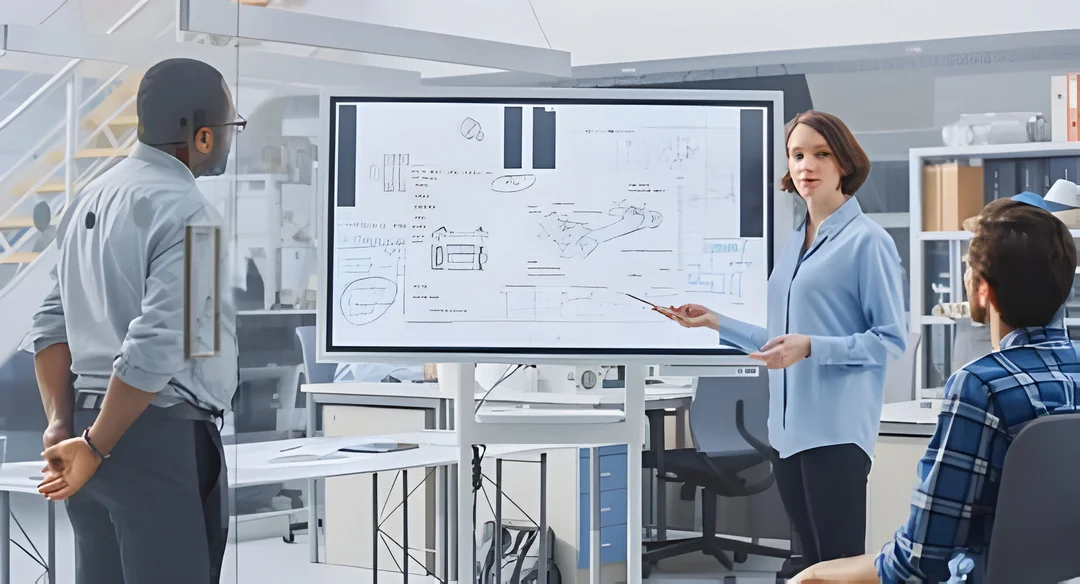- Video conference solutions simplifies remote communication, bridging geographical gaps for real-time interactions.
- These solutions provide all essential tools—cameras, mics, screens—for seamless collaboration.
- Diverse platforms offer unique features, catering to varied business sizes and budgets.
- Video conferencing fosters connectivity and productivity, aiding startups and large organizations alike.
Why Video Conferencing Is Important?
Enhances Effective Communication: Be it a small business or a corporate giant, crystal-clear communication is pivotal for comprehending projects, setting expectations, and meeting goals. Video conferencing solution adds a visual edge as research by Forbes shows humans process visuals faster than text or audio. Executives agree that video significantly boosts communication quality and understanding, engaging participants and aiding comprehension.
Fosters Relationship Building: Face-to-face meetings forge personal connections, allowing cues, trust, and rapport to develop. Even for remote teams or clients, video conferencing bridges geographical gaps, nurturing bonds.
Economizes Financial Resources: Bid farewell to expensive travel. Video conferencing mimics in-person interactions without the burden of airfare, freeing up valuable resources.
Saves Valuable Time: Say goodbye to time-consuming journeys to meetings. Video conferencing permits virtual gatherings from any location, redirecting focus to crucial tasks.

Facilitates Seamless Collaboration: It’s not just seeing and hearing; it’s about effective teamwork. Features like screen sharing and live document editing render collaboration effortless.
Enhances Operational Efficiency: Crisp communication, real-time cooperation, and location-agnostic participation render video conferencing a time-efficient tool. Meetings conclude promptly, expediting project completion.
Amplifies Workforce Productivity: Eliminate lengthy email threads and version confusion. Real-time collaboration ensures everyone contributes, queries get immediate answers, and projects progress smoothly.
Simplifies Meeting Scheduling: For the traveling team, scheduling meetings can pose a challenge. Video conferencing accommodates participation from virtually anywhere via various devices, simplifying coordination.
Maintains Accurate Documentation: Bid farewell to overlooked details. Video conferencing tools often incorporate secure recording and transcription, preserving a meticulous record of meetings.
Enables Live Engagements: Connect with your team, clients, or a global audience with ease. Video conferencing solution empowers hosting webinars, product launches, and events, reaching a diverse audience.
In today’s business landscape, video conferencing isn’t merely convenient—it’s a vital tool for maintaining connectivity, productivity, and competitiveness.
The Evolution of Video Conferencing Solution:
Video conferencing is an internet-based, live visual link connecting remote parties, mimicking in-person meetings. It’s a vital part of unified communications (UC) platforms, available as hardware, software, or SaaS. The journey began in the 1870s when Bell Labs conceived transmitting images and audio via wire. Fast forward to the 1920s, when Bell Telephone Laboratories broadcasted live moving images. In the late 1990s, consumer webcams gained popularity. Yet, it wasn’t until the early 2000s, with widespread broadband access, that companies widely adopted video conferencing. Today, SaaS and web-based platforms like Cisco’s Webex, Google Meet, Microsoft Teams, and Zoom are central to business collaboration, communication, and presentations. The concern has shifted from user adoption to issues like video meeting fatigue, affectionately known as Zoom fatigue, highlighting its ubiquity in modern work culture.
Video Conferencing: Challenges and Issues
Video conferencing solution brings benefits and hurdles. A key challenge is reliable high-speed internet, crucial for remote users in areas with web limitations. Costly hardware and upkeep pose adoption difficulties for some. Platform-specific limitations, like those in free Google Meet and Microsoft Teams versions, affect user experience and accessibility.
Video Conferencing Security:
Growing Concerns:
As video conferencing expands, security becomes paramount. Telehealth, a popular application, faces privacy regulations. Usage guidelines dictate feature access and user permissions.
Security Expert Tips:
Ashwin Krishnan, a security expert, offers 11 video conferencing security best practices:
- Enforce starting rights for meetings.
- Enable the waiting room and verify attendees.
- Avoid reusing meeting IDs.
- Add a meeting password.
- Lock the meeting once quorum is reached.
- Notify attendees about recording.
- Utilize a virtual background.
- Exercise caution in chat rooms.
- Maintain updated software.
- Implement encryption.
- Disable unnecessary features.
A Concise History of Video Conferencing:
Pioneers in Innovation:
AT&T Bell Labs and John Logie Baird pioneered video conferencing in the 1920s, sowing the seeds for video phone advancements.
Broadband Era Emergence:
In 2004, with widespread broadband access, businesses embraced video conferencing. It marked its early adoption.
Pandemic’s Influence:
COVID-19 accelerated video conferencing adoption. It became vital for remote work, complying with social distancing rules.
Evolutionary Journey:
Video conferencing transformed from humble beginnings into a potent communication tool, reshaping work, learning, and interaction.
Modern Advancements:
Today, platforms like Kumospace, WebEx, Zoom, Microsoft Teams, and Google Meet push boundaries in remote communication and collaboration.
Implementing Video Conferencing:
Unlocking API Benefits:
APIs bring a range of capabilities, such as virtual backgrounds. Maldow advises on selecting API vendors wisely.
Endpoint Evaluation:
Endpoints play a pivotal role. Assess employee video usage, their roles (customer-facing or not), and funding for endpoints.
Customized Approach:
Each organization tailors video conferencing based on user needs, especially in hybrid work settings.
How to Set Up Video Conferencing
Connecting to a video conference from your laptop is simple enough. Download your favorite video conferencing app, select to use your embedded webcam and microphone, pop in some headphones and connect to your virtual meeting room. But most meetings include at least one meeting room for groups to join together. Sliding a laptop with a Skype call to the end of the meeting room table and crowding around it isn’t the answer. There’s a better solution for web conferencing, and it doesn’t include complicated conferencing software and dongles. Here’s how to set up a video conference room so you can conduct productive and professional business meetings.
3 Items Needed To Setup Your Video Conference Room
Cloud-based video conferencing makes it incredibly simple for anyone to spin up a video conferencing room in about ten minutes. Here are the three components you’ll need when setting up video conferencing:
- Connected TV (or multiple displays)
Conference rooms can vary in size from small huddle rooms to large boardrooms, and it’s important to match the display to the size of the room. Our article on choosing a video conferencing screen provides more details on the benefits of 4K displays and how dual displays can provide a dedicated presentation space, but the general rule of thumb is the bigger the room, the bigger the display.
- Video Conferencing System
Composed of a high-definition camera and full video processing codec, a video conferencing system sends and receives encrypted video information and decodes it as live video on your meeting room display. Just as a webcam requires the processing power of your laptop to function, a video conferencing system is much more than just a camera. Lifesize favors UDP to reduce delays and ensure smooth calls every time.
All-in-one systems like the Lifesize line of 4K video conferencing systems are purpose built for the meeting room and designed for the sole purpose of capturing and transmitting flawless live 4K video feeds over the Lifesize cloud service network.
- Conference Phone
A touchscreen conference phone provides a dedicated user interface for navigating your directory, controlling the camera pan/tilt/zoom options and launching calls. Conference phones and conference call microphones purpose-built for video conferencing will feature echo cancellation, automatic gain control and automatic noise reduction to give meeting room and conference participants crystal-clear audio.

The End
Effective communication and teamwork depend on choosing the best video conferencing solution option. Successful virtual meetings are facilitated by well-equipped conference rooms, dependable AV suppliers, and adherence to meeting protocol. Having stated that, AV needs to be documented to facilitate seamless video conferencing.
FAQ
How can you connect people on video conferencing?
Connecting people through video conferencing offers multiple options. It involves utilizing web cameras linked to or integrated into laptops, tablets, and desktop computers. Additionally, smartphones and other mobile devices equipped with cameras enable seamless participation in video conferences. In such instances, a software-based platform typically is used to transmit the communication over internet protocols.Some businesses use dedicated video conferencing rooms that have been equipped with high-grade cameras and screens to ensure the conversation is clear and with limited technical faults. Third-party providers often install and assemble the hardware needed to conduct the video conference.
What is the new technology in video conferencing?
Think of 3D graphics that can be shared with other call participants and manipulated by all parties during a video conference. This can be used for collaborative image browsing, 3D design modelling, immersive storytelling, online lectures, business presentations, product showcases and more.
Another way of using video conferencing apps for virtual collaboration is troubleshooting, tech support and customer service. Gartner suggests that 75% of capital-equipment-intensive industries plan to introduce AR as a key component in reducing costs associated with frontline workers by 2026. Manufacturing, maintenance and service workers can now remotely display instructions, troubleshoot problems and help customers more efficiently with AR tools for self-service and real-time remote assistance.
How do I connect with someone virtually?
It sounds corny, but have you ever done it? It can be really wonderful. Talk about whatever you want, work, life but if you talk about work, don’t talk about projects or action items. Focus more on feelings, things you’re excited about, frustrated about, etc. to provide a sense of connection.Pad your online interactions with time for informal chat. Get the team together and have everyone bring a beverage or snack of choice. Play an online game (my office is exploring the Jackbox suite of games you play through your phone and computer).




